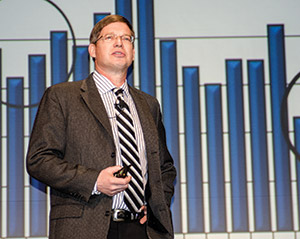U.S. Cow Herd is Rebuilding
Improved weather outlook, lower input costs are expected to encourage heifer retention, tightening the supply of fed cattle.
NASHVILLE, Tenn. (Feb. 5, 2014) — Total cow slaughter is projected to be down by nearly 600,000 head in 2014, and heifer retention is projected to be up, which is a pretty good indicator U.S. beef producers are in the process of retaining females to begin expanding the U.S. cow herd, according to CattleFax analyst Kevin Good.

In the short term, rebuilding the cow herd will take about 10,000 head a day out of the harvest mix for the next couple years, leading to tighter supplies and aggressive bidding among feedyards to maintain occupancy levels, explained Kevin Good.
“That’s what it takes to turn the ship around,” Good said as he addressed attendees at the 2014 Cattle Industry Convention Feb. 5 in Nashville, Tenn. “We are in the process of starting to rebuild the herd over the next couple of years.” He credited improvements in moisture conditions and a decrease in input costs for helping stabilize the beef herd and allowing for rebuilding in 2014 and into 2015.
This ends a 16-year cycle of liquidating the cow herd. “The late 80s to early 90s was the last we (the United States) truly expanded by about 3 million head,” Good said. That was about a 9% increase.
While rebuilding the cow herd is needed, in the short term it will take about 10,000 head a day out of the harvest mix over the next couple years, Good explained. Tighter supplies will likely create aggressive bidding among feedyards in an effort to maintain occupancy levels. As a result, he said, don't be surprised if packing capacity is downsized by another one, two or three plants. CattleFax is forecasting fed slaughter to total 24.9 million head in 2014.
Good added, “We’re not going to produce more beef as we expand,” but pork and poultry will likely grow production and some consumption in that time.
Specifically for net beef supplies the rebuilding scenario will mean a 3.5% reduction (900 million pounds) in 2014 due to reduced total cattle slaughter. The tighter supplies will also continue to drive higher beef prices at restaurants and retail.
Despite that, Good said, beef in fine-dining and fast-casual restaurants is still “doing well,” and CattleFax anticipates beef demand should remain steady to 1% higher in 2014.
Editor’s Note: The above article was written under contract or by staff of the Angus Journal. It may not be reprinted without express
permission of the Angus Journal. To request reprint permission, contact the editor at 816-383-5200.
www.4cattlemen.com is an event coverage site provided by the Angus Journal editorial team,which publishes the Angus Journal, the Angus Beef Bulletin, the Angus Beef Bulletin EXTRA and the Angus Journal Daily. For questions about this site, to submit an article for our consideration, or to report a broken link, contact the editor at 816-383-5200; 3201 Frederick Ave., Saint Joseph, MO 64506.
The Angus Journal claims copyright
to this website as presented. We welcome educational venues and
cattlemen to link to this site as a service to their audience.

